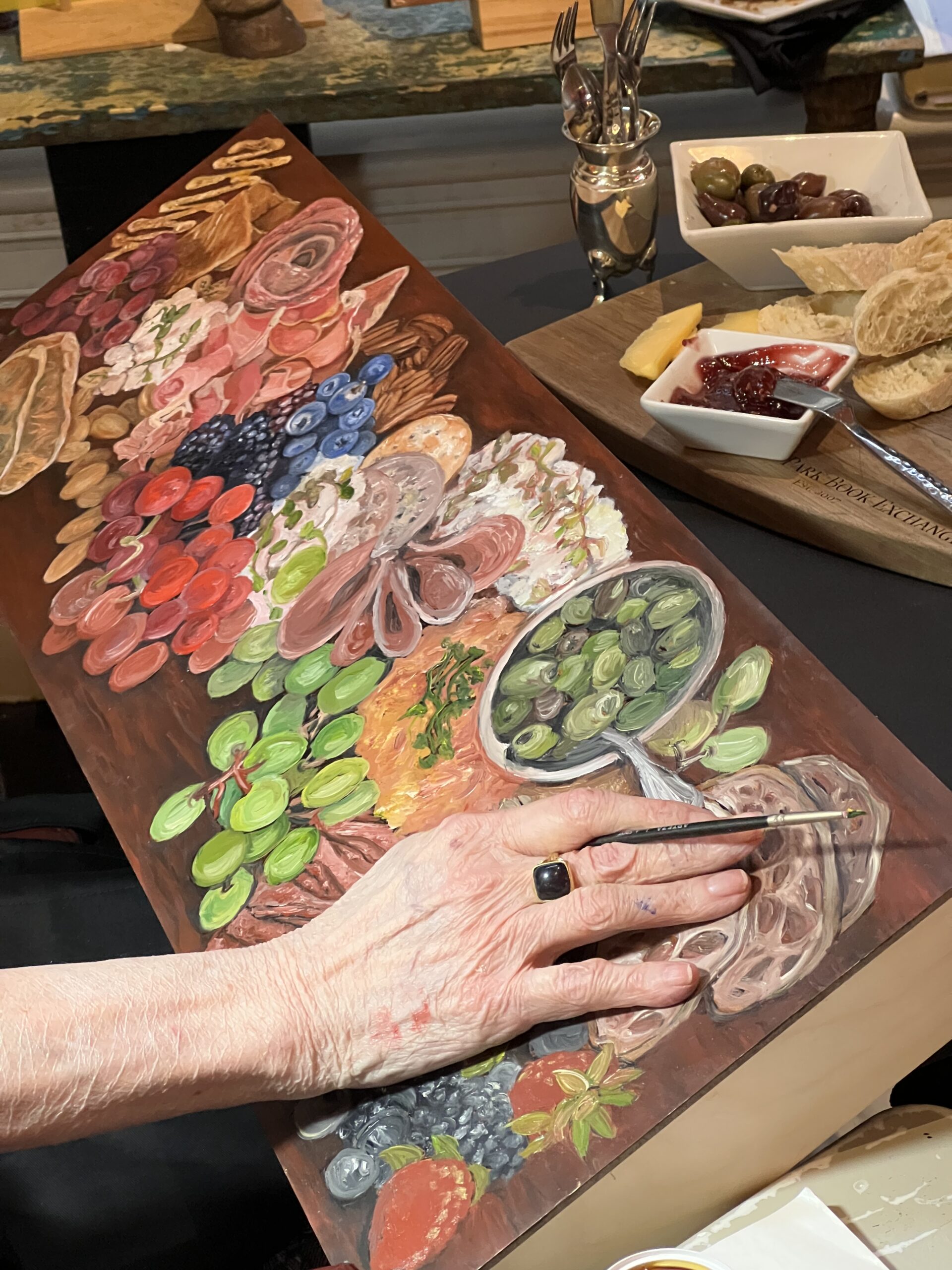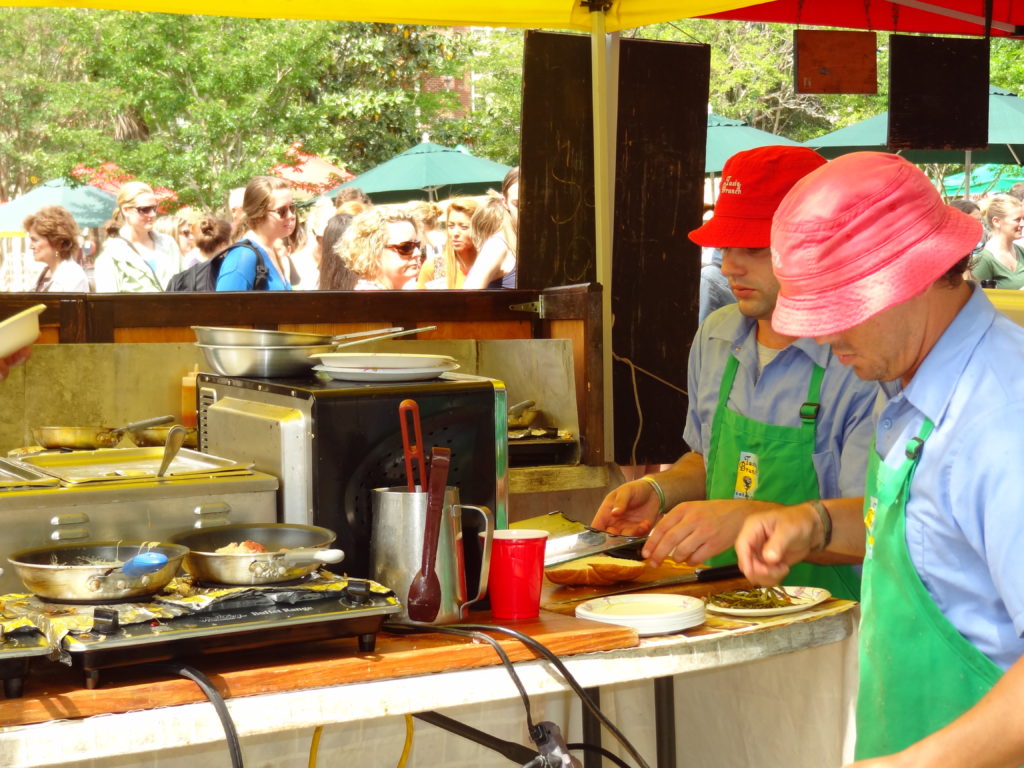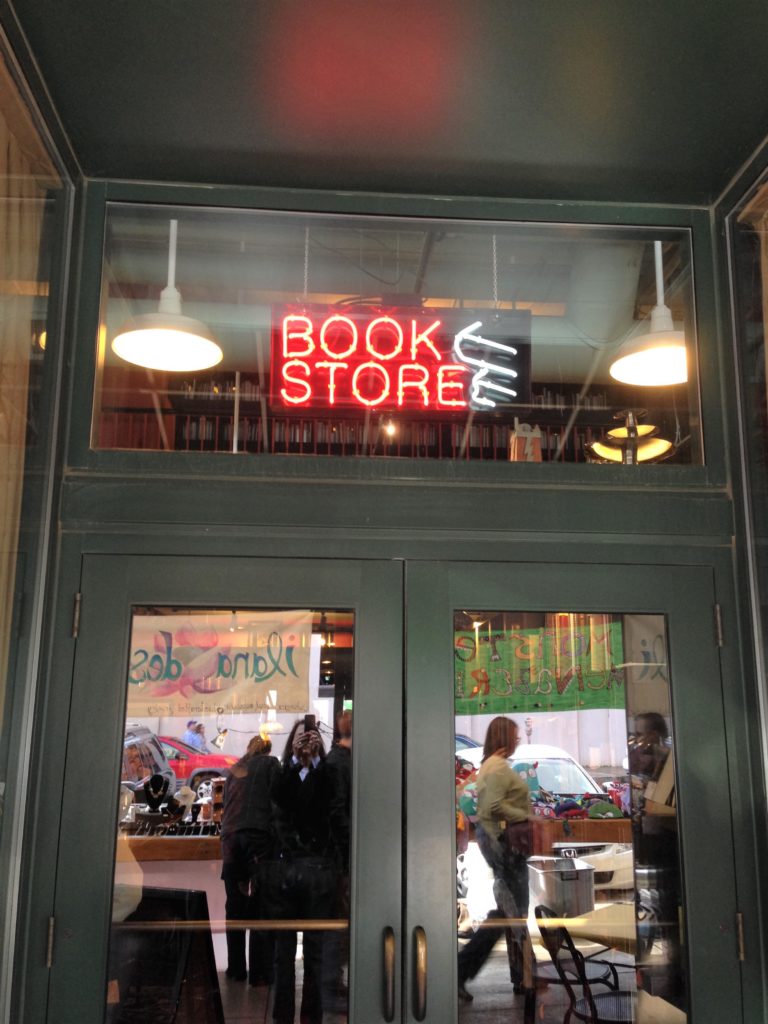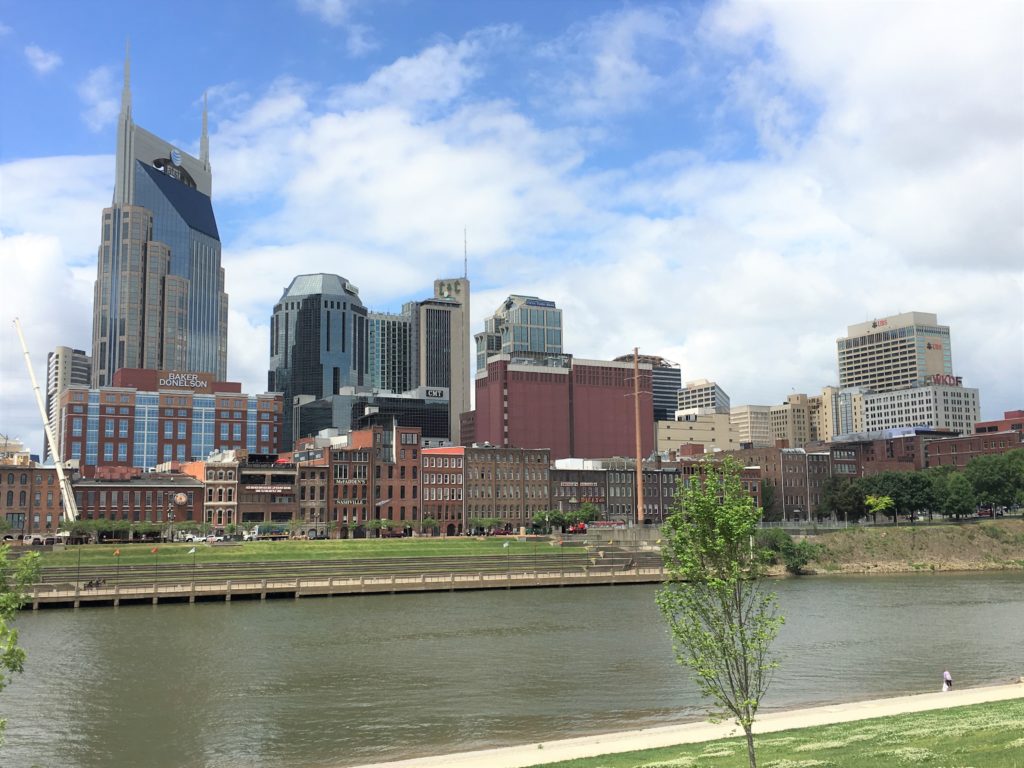Asheville, NC is a culinary farm-to-table exploration at every turn, featuring some of America’s best chefs and young stars. The question is where to start, and for a weekend journey, what to prioritize? For our girlfriends’ four-day visit, as a seasoned traveler I consulted my most reliable resources – recent books/articles about Carolinas cuisine, recommendations by our innkeeper, old faithfuls from past visits and word-of-mouth.
Dining wasn’t the only consideration because Asheville is also a vibrant destination for Blue Ridge Mountains culture – art, history, landscapes and music. We simplified our planning by building each day around meals and, secondarily, our visit to the historic Biltmore Estate. This outline allowed us to book reservations at our top-choice restaurants and have wiggle room for serendipity.
And, I can’t repeat this enough for popular travel venues, especially during this post-pandemic surge of get-aways, YOU MUST PLAN AND BOOK WAAAY AHEAD to get what you want. Asheville is busy with tourists year-round, but in early spring, before the summer’s flood of people, we found that starting two months before we’d arrive allowed us our preferred options (in most cases). For summer and fall, start at least 3-6 months out. Most of the restaurants are on Resy or Open Table, or have their own online booking links.
First, the Place to Stay
Asheville is loaded with delightful inns and B&Bs that reinforce the personality of the community. As a result, the first “old faithful” from my list was Carolina Bed and Breakfast, a gracious inn in the historic Montford district – a quiet, unassuming district that features sprawling Victorian homes (and several B&Bs) and a short 20-minute walk from the city’s bustling center. That’s a bonus since there finding parking downtown during the busy times can be frustrating. The inn changed hands in the 10 years since I was last there. Diana Thornton and Kevin Gero purchased the inn from Susan and James Murray, who had hosted us before.
The Murray’s bright art and artifacts from their global travels have been replaced by Diana’s quieter cozy-modern décor that you simply sink into. Her rich, sweet and savory, and always more than ample, breakfast presentations are to-die-for; a light eater and mostly low-fat eater, I politely dialed back a bit on portions or request alternatives or I wouldn’t have had room for the rest of the dining experiences we’d scheduled in foodie heaven!. The redesigned property preserves the personalities of the individual rooms/suites, the warm hospitality, the expansive porches for relaxation and the lovely gardens. I opted once again for the spritely Goldfinch Room with king bed and a spa bath, and my Womantraveler pal chose the stately Miss Webb Room with its cherry four-poster bed and built-in library theme.
Second, the Biltmore Estate
“It is doubtful whether, either in the Old World or New, a builder has ever erected a nobler residential edifice than the Southern home of Mr. George Vanderbilt.” George Hill, Architectural Record, October-December, 1895.
Modeled after a French Renaissance chateau, George Vanderbilt’s Biltmore House may be a familiar landmark, but what was most impressive to me on this visit was its back story. In the 1890s, this massive, luxurious 250-room edifice, branded as “America’s Largest Home” (the house itself is about 4 acres in size), is an engineering feat, designed by architect Richard Morris Hunt and built before the existence of modern construction machinery in an extremely remote location on a mountaintop. In fact, rail lines had to be constructed across uneven mountain terrain with deep gullies and ridges, supported by trestles, to transport heavy materials from the railroad depot several miles away. Materials were shipped from Europe (i.e., the marble used in the interior) or long distances stateside (the limestone was quarried in Indiana, for example). Wooden derricks were rigged with pullies and hand-cranked winches to transport the materials along the rail lines. There were other forward-thinking considerations, such as the slate roof that contained no wood to enhance fire safety. Inside, the decorative features were also modern for the times – including 288 electric light fixtures, 43 bathrooms with indoor plumbing and two electric Otis Brothers & Co. elevators. In addition to 35 bedrooms and 65 fireplaces, the chateau even has a swimming pool and a gym.
The estate’s website is an excellent planning tool, so start there. We selected the self-guided audio tour, which was loaded with detailed information on every room, and augmented by displays in the rooms with photos and text. (We also eavesdropped on a couple of private tours for additional insider perspectives!) We learned that the banquet room (pictured below) has a seven-story ceiling and that the tapestries from the 1500s took five years to design and another five to weave. There are 22,000 books in the house, 10,000 in the banquet room alone. Be aware that there are several steep flights of stairs, which require sure footing. The ticket is pricey ticket – for adults it’s currently from $79 to over $300, depending on the features – but there are various specials and discounts available from the website and tour partners and inns, such as the Carolina B&B.
We enjoyed a resplendent half day on the current 8,000-acre estate, with spectacular vistas to the Blue Ridge Mountains, both touring the chateau and pleasant walks through parts of the 75-acre formal and informal gardens designed by renowned landscape architect Frederick Law Olmstead. (Originally the Vanderbilts owned 125,000 acres but sold much of that to help create Pisgah National Forest.) Visitors also have access to a winery, restaurants, accommodations, various exhibits and hands-on experiences around the property. Olmstead sited the road into the vast property as a series of bends so guests could anticipate what might be coming but could not actually see the mansion until right upon it. The spacious courtyard with several snack and drink options was a welcoming finish to our touring.
Most Importantly, the Food Scene in Asheville
In “Finding Foodtopia” in Edible Asheville magazine’s 2023 Visitors Companion, writer Kay West describes how this once small town in the North Carolina mountains became a culinary powerhouse over the past 40 years. With the aspiration of “farm-to-table,” then a new idea, the early innovators drew on the regional advantage of the Western North Carolina Appalachian food scene – abundant farms and ranches producing year-round – delivering seasonal products from locally made cheeses and breads to game, mountain trout, produce, wine and more. As more and more talented and ambitious chefs migrated to the region, several with James Beard Foundation recognition, and food production became more intentionally organized into an ecosystem, Asheville’s appeal and reputation grew exponentially – and internationally. And it’s eclectic – one of my favorite wine bars is at the Battery Park Book Exchange & Champagne Bar, where you can sip bubblies and wines from a distinctively curated list, all the while surrounded by stacks and stacks of books. At happy hour, a jazz duo played, a girls-night-out group lounged around a coffee table in another room of books and, around the corner and down the hall, still in the bookshop, an artist “performed” with her interpretations of a sumptuous charcuterie board display.
I put Rhubarb on my list of “musts” for this visit, giving it the Saturday night “finale” position, after reading about chef owner John Fleer in Edible North Carolina: A Journey Across a State of Flavor, a fascinating book published last year about the distinctive regions of NC’s contemporary food landscape and the stories about the people who make it happen. Asheville, Fleer is quoted as saying, “has always been a community of people who just are hell-bent on doing something interesting.” From our dinner menu (changed daily according to what’s fresh in the local market), I chose “Today’s House Cures and Local Cheeses” – a board of bresaola, pork rillettes and lamb/asparagus terrine along with two local cheeses – “Magnolia” (cow/gouda/semi soft) and Bearwallow (cow/tomme/nutty) from Looking Glass Creamery. They were accompanied by a house made lavash, house made mustard, ramps (in season for a short few weeks). Along with them, we shared a spring radish salad with frisée and green goddess style dressing. Complementing the flavors was a Rose of Pinot Noir by Napa Valley vintner Robert Sinskey.
“Appalachia is ripe with unique indigenous ingredients, both prepared and raw,” the menu explained. “To cook from its larder is a joy. While you are here, we hope you experience the table as a place where a community is created that extends beyond the food, where memories are both made and rekindled.” From beginning to end, coupled with a view of the high-energy open kitchen, the convivial dining areas and the personalized service, Rhubarb delivered completely on that promise.
The first evening at Table was equally delish in a different way. Smaller, cozier and lean in design, like a casual corner eatery, Table has the intimacy of a neighborhood restaurant that stands out for its low pretense, gracious service and culinary polish. My Ricotta cavatelli with rabbit sugo (ragout), preceded by shared plate of local lettuces and finished by a Gamay Beaujolais off an extensive wine list left me recalling the quality unassuming country French bistros where high quality is simply the baseline.
We couldn’t get a reservation at Curate, a popular tapas bar, at a time that fit our itinerary (even a month out), but you can read more about this must-do dining experience from my previous trip to Asheville here.
Lastly, but importantly, Shopping Serendipity
While at the Biltmore House, we passed through Historic Biltmore Village just outside the front gate and two miles from downtown Asheville. Vanderbilt developed this “village” to accommodate the small army of artisans and craftsmen hired to create his vision of Biltmore House. Today it’s transformed into 70 distinctive shops, art galleries, breweries and restaurants. Frankly I was a bit leery at first, as the buildings are a tad on the Disney-esque side in appearance. Since we hadn’t found much of interest in Asheville’s downtown boutiques, we took pot-luck in Biltmore Village based on word-of-mouth and were delighted that we did.
This Womantraveler gravitates like a magnet to retail boutiques. We had tremendous fun in Eileen’s, a women’s clothing shop (3 Swan Street, Asheville NC 28803, tel. 828.243.0072) trying on clothing from a thoughtful array of contemporary styles that weren’t hopelessly juvenile for us. After our shopping bags were full from that adventure, we “rested” in Provisions Mercantile South, a homestyle store and market, over draft wine and inventive charcuterie boards of meat and cheese. (Provisions South, 14 Lodge Street, Asheville, NC 28803, tel. 828.5050.0592). Nearby, the Southern Highland Craft Guild’s shop is a definite stop; I’ve been to the one near Blowing Rock, NC, and always take the opportunity to peruse the beautiful assortment of textiles, pottery, jewelry and more from the mountain region’s exceptional artisans and their distinctive styles.
Other Resources – More Ways to Plan and Visit the Asheville Region
Breweries In & Around Asheville, NC – a comprehensive guide, locator maps and tasting notebook.
WNC Farmers Market, 570 Brevard Road, Asheville 28806; tel. 828.253-1691 (361 days a year).
Edible Asheville Magazine (online version) – and you can find free copies around the city.
Asheville Discovery Map (online version to check out while planning) – and be sure to pick up for quick reference while in the area.
Black Mountain, NC – billed as a day trip from Asheville, it’s a destination in itself if you have the time. About 30 minutes on the way down the mountain east on Interstate 40, Black Mountain is total charm, warm welcomes and terrific shopping – I drive up a couple of times a year. As a side trip from Asheville or a journey on its own, it’s an easy half-day experience. One of my favorite toy stores anywhere, Sassafras on Sutton, has a combination bookstore, gift and coffee shop downstairs, with overstuffed chairs for a short but necessary pause to regroup and refresh after all the boutiquing. Also check out Spice It Up for spices, oils, vinegars and teas; Black Home & Accents for quilts, flowers, linens, accent furniture and other decor; and Black Mountain Bistro for a yummy lunch with regional culinary flair and hospitality.




